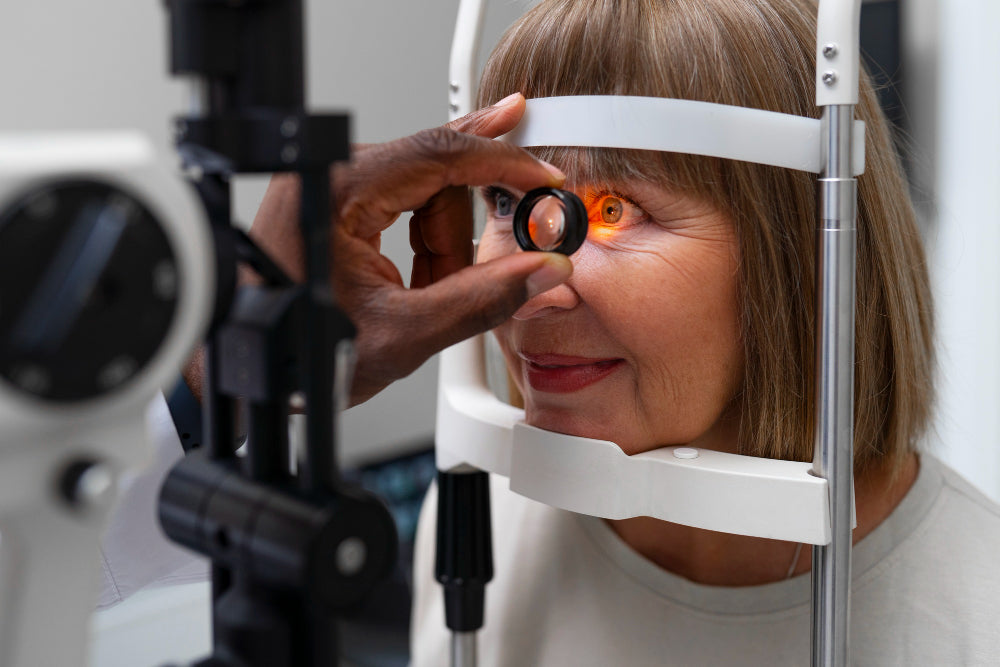Last year, Emily woke up to find her world suddenly blurred, like a mist had settled over her eyes. The experience was unsettling, leaving her wondering what could have gone wrong overnight.
Like Emily, millions of people face this reality every day, unaware they may be dealing with glaucoma—a silent thief of sight that strikes without warning. But what is glaucoma, and how does it so stealthily threaten our vision?
Glaucoma is a group of eye disorders that damage the optic nerve, which transmits visual signals from the retina to the brain. This damage is often caused by increased intraocular pressure (IOP) but can also occur even when eye pressure is normal.
For those curious about the causes and symptoms of glaucoma, let's explore the complexities of this vision-threatening condition more thoroughly.
What is Glaucoma?
Unlike Cataracts, Glaucoma encompasses a range of eye disorders that harm the optic nerve, vital in carrying visual information from the eyes to the brain.
This damage is most frequently associated with elevated intraocular pressure (IOP), although glaucoma can manifest even when eye pressure is considered within normal limits. The disease predominantly affects older adults, making it one of the foremost causes of blindness in individuals over the age of 60.
Exploring the various types and their distinct manifestations is essential to fully comprehending the nature of glaucoma.
Symptoms of Glaucoma

The symptoms of glaucoma are often subtle, particularly in the early stages of the disease. Many individuals remain unaware of their affliction until significant damage has occurred.
Recognizing the diverse glaucoma symptoms is imperative for early diagnosis and prompt intervention, which are critical to mitigating irreversible vision loss.
Open-Angle Glaucoma
Open-angle glaucoma is the most common form of the disease, characterized by its slow and gradual onset. This type of glaucoma often progresses unnoticed in its early stages, as it typically presents no apparent symptoms, leading to a false sense of security that vision remains unaffected.
As the condition advances, symptoms may include:
- Gradual Loss of Peripheral Vision: This is often referred to as "tunnel vision," in which side vision slowly diminishes while central vision remains intact.
- Difficulty Adjusting to Low Light: Challenges in seeing in dimly lit environments or transitioning from light to dark.
- Blind Spots: The development of small, unnoticed blind spots in the peripheral vision that may go undetected until significant vision loss has occurred.
Acute Angle-Closure Glaucoma
By contrast, acute angle-closure glaucoma manifests with alarming rapidity and intensity. This variant is characterized by a sudden elevation in intraocular pressure, usually precipitated by a blockage in the eye's drainage system.
Symptoms are pronounced and include:
- Severe Eye Pain: A sharp, stabbing pain that can be debilitating.
- Nausea and Vomiting: Often accompanied by a profound sense of unease or anxiety.
- Sudden Blurred Vision: An abrupt decline in the ability to see clearly.
- Halos Around Lights: A phenomenon that is particularly disorienting and distressing.
- Ocular Redness: A visible sign of increased intraocular pressure and inflammation.
Acute angle-closure glaucoma constitutes a medical emergency; without immediate treatment, permanent vision loss can ensue.
Normal-Tension Glaucoma
Normal-tension glaucoma occurs in patients whose intraocular pressure is within normal parameters. Despite the absence of elevated pressure, the optic nerve still sustains damage, potentially due to factors such as reduced ocular blood flow or increased vulnerability of the optic nerve fibers.
The symptoms of normal-tension glaucoma often mimic those of open-angle glaucoma, including a gradual diminution of peripheral vision.
Glaucoma in Children
Although predominantly an adult affliction, glaucoma can also present in pediatric patients, posing unique diagnostic and therapeutic challenges. Pediatric glaucoma may be congenital or develop during childhood.
Symptoms in infants often include:
- Opaque or Cloudy Eyes: Indicative of heightened intraocular pressure.
- Excessive Lacrimation: Frequently mistaken for allergies or benign conditions.
- Photophobia: An aversion to light that causes discomfort or distress.
Prompt diagnosis and intervention are crucial to avert long-term visual impairment in pediatric cases.
Pigmentary Glaucoma
Pigmentary glaucoma arises when pigment granules from the iris detach and obstruct the eye's drainage channels, impeding aqueous outflow. This condition may lead to fluctuating vision and is often exacerbated by physical exertion.
Symptoms can include:
- Intermittent Blurred Vision During Physical Activity: A frequent complaint among those affected.
- Halos Around Lights: Similar to other glaucoma types, suggesting possible optic nerve compromise.
Causes of Glaucoma
But what causes glaucoma? The etiology of glaucoma is multifaceted and can vary depending on its type, though it is generally linked to intraocular pressure dynamics.
Elevated intraocular pressure results from the impaired drainage of aqueous humor, the clear fluid that nourishes the eye. The following are some of the primary causes and risk factors:
Elevated Intraocular Pressure: The most prominent risk factor for most forms of glaucoma.
Age: Individuals over the age of 60 are more susceptible.
Genetic Predisposition: A family history of glaucoma significantly increases one's risk.
Ethnic Background: People of African, Asian, and Hispanic descent face a heightened risk.
Medical Conditions: Conditions such as diabetes, hypertension, and cardiovascular disease may elevate the risk of developing glaucoma.
Early Detection and Treatment is Imperative

Detecting glaucoma early and managing it proactively is crucial for preventing vision loss. Regular comprehensive eye examinations, including Optomap retinal exams and ORA Ocular Response Analysis, can facilitate early diagnosis. Treatment options vary but often include:
- Medications: Eye drops that lower intraocular pressure and decelerate disease progression.
- Laser Therapy: Procedures designed to enhance aqueous outflow or decrease aqueous production.
- Surgical Intervention: In advanced cases, surgical procedures may be warranted to create new drainage pathways or decrease fluid production.
Conclusion
In summary, glaucoma is a multifaceted and potentially debilitating condition that poses a formidable threat to vision. Understanding what glaucoma is, recognizing its symptoms, and being aware of what causes glaucoma are vital steps in protecting your eyesight.
Remember, the best defense against this silent thief of sight is vigilance, awareness, and timely intervention. Vision Source Rio has skilled optometric physicians who have treated thousands of patients for glaucoma. Act now to safeguard your vision for the future. Schedule an appointment today.
Read Further:





